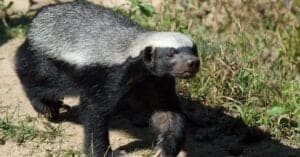Honey Badger vs Mongoose: 5 Key Differences
@media (min-width: 481px) {
.mobile-top-content {
display: none;
}
}
#mobileTopContentCTACarouselControls { overflow: hidden; text-overflow: ellipsis; white-space: nowrap; }
.mobile-top-content .more { color: #fff; }
.mobile-top-content a { color: #fff; text-decoration: underline; }
.mobile-top-content a:hover { color: #fff; text-decoration: underline; }
@media (max-width: 480px) {
.mobile-top-content {
background-color: #06a10b;
color: #fff;
text-align: center;
/*height: 60px;
padding-top:5px;*/
font-size:80%;
/* display: block; */
margin: 0px -30px;
}
}
Have you ever considered all of the differences between a honey badger vs mongoose? While both of these animals are unique in their ability to resist snake venom, this is almost where their similarities end. But what are all of the differences between honey badgers and mongooses, and how can you learn how to tell them apart?
In this article, we will address all of the similarities and differences between these two creatures, including their geographical locations and habitat preferences. We will also talk about their physical appearances as well as their behaviors, both with their own kind and with predators. Let’s get started and learn all about honey badgers and mongooses now!
Comparing Honey Badger vs Mongoose
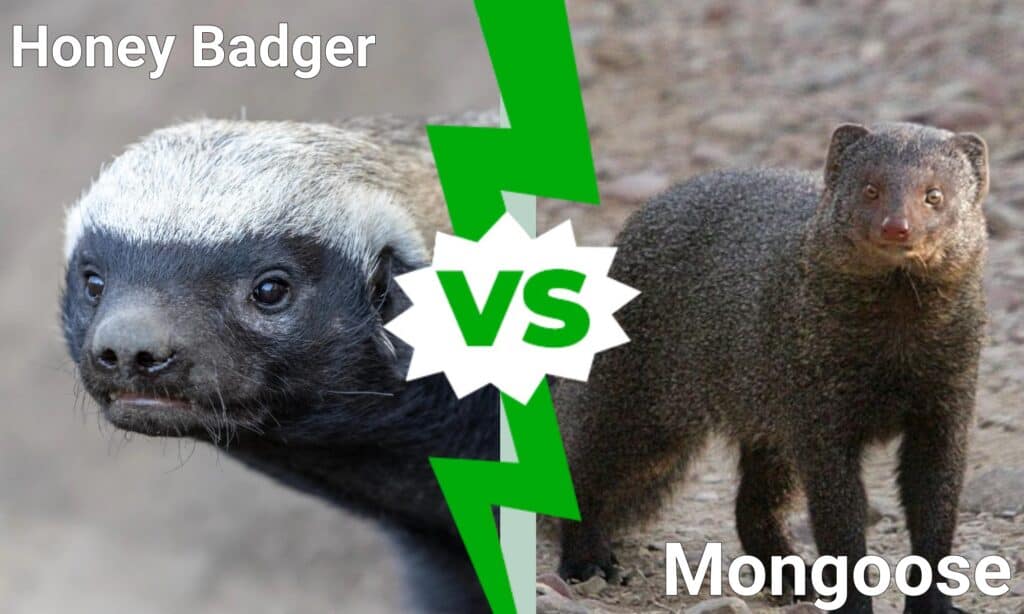
A-Z-Animals.com
| Honey Badger | Mongoose | |
|---|---|---|
| Size | 10-35 pounds; 2-4 feet long | 1-10 pounds; 1-3 feet long |
| Appearance | Coarse black fur with white markings similar to a skunk; long body with short tail and snout | Weasel-like in appearance; typically brown or gray with stripes rarely. Long tail and stubby legs and snout |
| Lifespan | 7-10 years | 10-15 years |
| Behavior | Notoriously aggressive; typically solitary in behavior. Capable burrower, but often steals already made dens and holes | Very social with their own kind and capable of digging complex burrows. Communicates primarily through scent glands |
| Habitat and Location | Africa and Asia; prefers dry areas such as grasslands and forests | Africa and Asia; hot and tropical areas, though it depends on the species |
Key Differences Between Honey Badger vs Mongoose

Oscar David Toledo Marin/Shutterstock.com
There are many key differences between honey badgers and mongooses. The honey badger is far larger than the mongoose, both in size and weight. However, the lifespan of the mongoose is longer than the lifespan of the honey badger, at least in the wild. Honey badgers are notoriously aggressive with just about any creature, while mongooses enjoy complicated social structures that keep them safe.
Let’s discuss all of these differences and more!
Honey Badger vs Mongoose: Size

Erwin Niemand/Shutterstock.com
You can easily tell the difference between a honey badger and a mongoose based on their size. For example, honey badgers weigh anywhere from 10 to 35 pounds depending on age, while mongooses rarely weigh more than 10 pounds total.
Ironically, honey badgers and mongooses are similar in their overall body lengths. For example, mongooses average anywhere from 1 to 3 feet long, well honey badgers average 2 to 4 feet long. The mongoose’s tail is what makes it as long as a honey badger, the honey badgers still outgrow mongooses by a few feet.
Honey Badger vs Mongoose: Location and Habitat
Both mongooses and honey badgers live in Africa and Asia. They both enjoy dry and hot climates, though there are some differences depending on the species of mongoose that you are dealing with. For example, some mongooses enjoy swimming or climbing trees, while the majority of honey badgers prefer grasslands and terrestrial living.
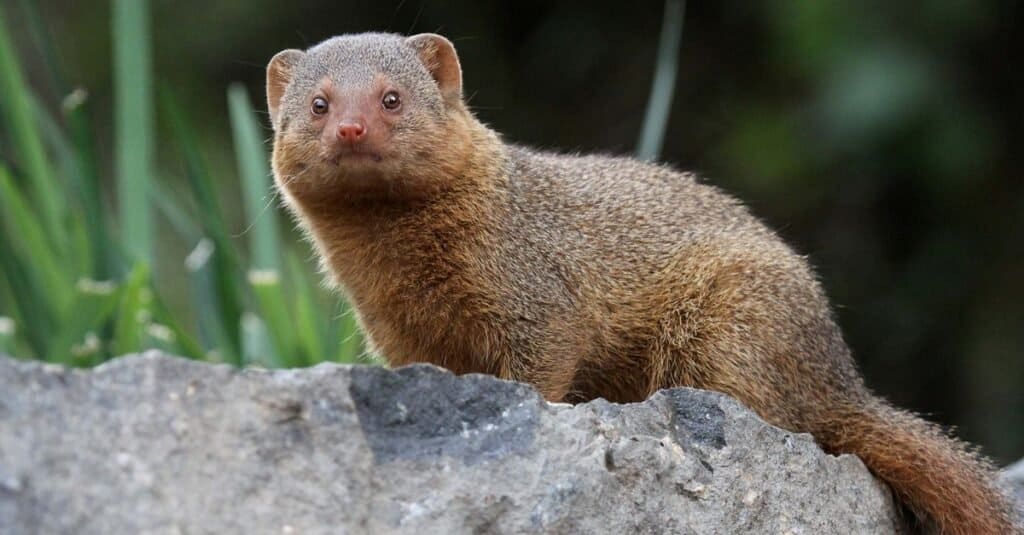
steve bushman/Shutterstock.com
Honey Badger vs Mongoose: Appearance
There are many differences in the appearance of a honey badger versus the appearance of a mongoose. Mongooses look similarly to weasels, while honey badgers look like overgrown skunks. For example, honey badgers are covered in coarse black fur with white stripes, while mongooses have long and skinny bodies in brown or gray fur.
Honey badgers have longer legs than mongooses do, though mongooses have longer tails than honey badgers do. Comparing these unique animals to skunks and weasels makes the most sense, and it may help you easily tell them apart upon first glance!
Honey Badger vs Mongoose: Behavior
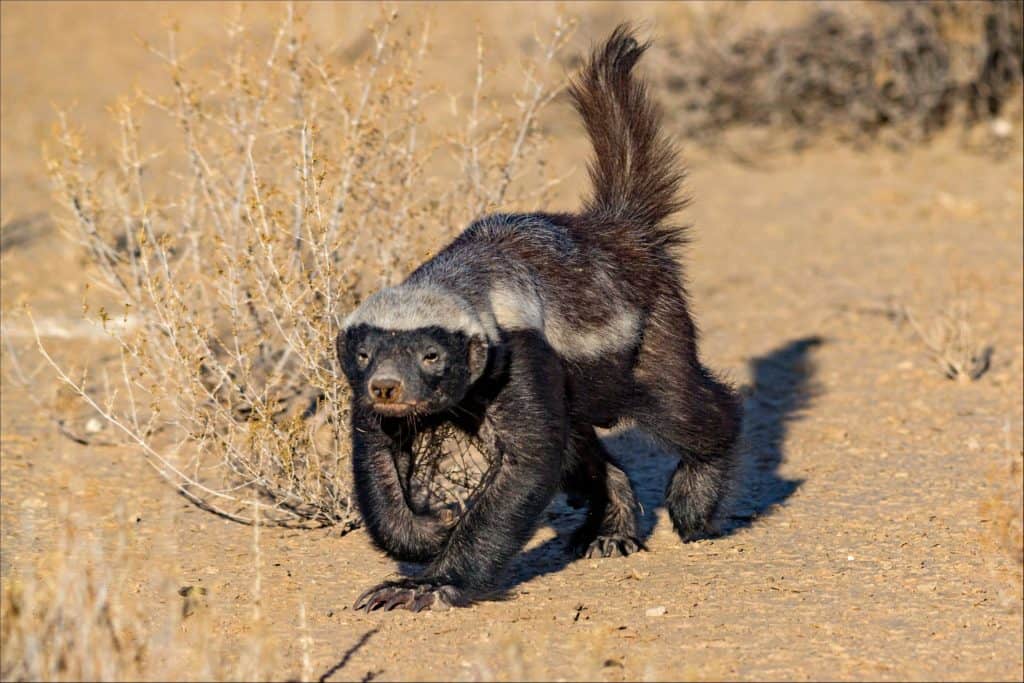
There are many different behavioral differences between honey badgers and mongooses. If you weren’t already aware, honey badgers are notorious for their aggression, while mongooses are regarded as relatively shy individuals. Mongooses are also cooperative and often have complicated social structures, while honey badgers remain solitary unless they are mating.
Both of these creatures are very capable when it comes to digging holes and creating burrows, though honey badgers often steal the dens of other creatures while mongooses build their own. Mongooses also communicate primarily through scent glands, while honey badgers do not utilize this behavior for themselves.
A similarity that these animals share is a natural resistance to venomous and poisonous animals. This has been studied by scientists for quite some time, especially considering the fact that both honey badgers and mongooses eat venomous snakes regularly. It’s an impressive trait that both of them share, likely gained through years of evolution!
Honey Badger vs Mongoose: Lifespan
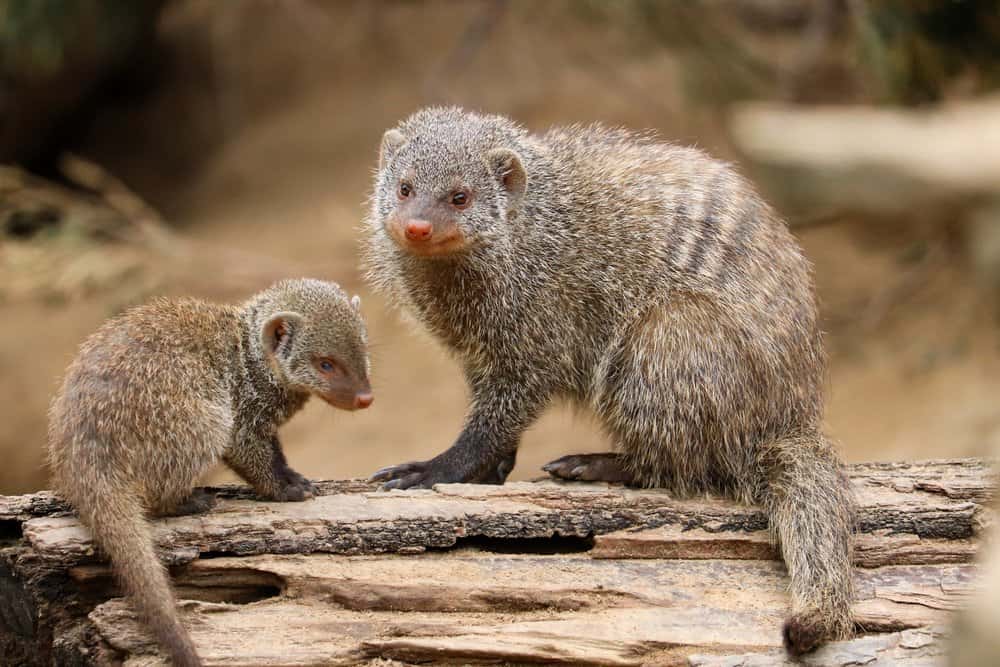
Cassidy Te/Shutterstock.com
A final difference between honey badgers and mongooses is their lifespan. While both of these creatures live longer lives in captivity versus in the wild, mongooses live longer overall compared to the lifespan of the average honey badger. Let’s discuss this in more detail now.
Mongooses live an average of 10 to 15 years in the wild, while honey badgers live an average of 7 to 10 years in the wild. However, some honey badgers live over 20 years in captivity, while mongooses tend to live closer to 10 to 15 years no matter their environment. Why might this be?
This is likely due to the fact that mongooses have some variety of protection when living in a group of other mongooses, while honey badgers live solitary lives in general. However, honey badgers are very difficult to harm or kill, so it is surprising to realize how short their lifespans truly are.
More from A-Z Animals
.more-snake-card-image { max-height:140px !important; }
@media (min-width: 481px) {
.mobile-top-content {
display: none;
}
}
#mobileTopContentCTACarouselControls { overflow: hidden; text-overflow: ellipsis; white-space: nowrap; }
.mobile-top-content .more { color: #fff; }
.mobile-top-content a { color: #fff; text-decoration: underline; }
.mobile-top-content a:hover { color: #fff; text-decoration: underline; }
@media (max-width: 480px) {
.mobile-top-content {
background-color: #06a10b;
color: #fff;
text-align: center;
/*height: 60px;
padding-top:5px;*/
font-size:80%;
/* display: block; */
margin: 0px -30px;
}
}
Have you ever considered all of the differences between a honey badger vs mongoose? While both of these animals are unique in their ability to resist snake venom, this is almost where their similarities end. But what are all of the differences between honey badgers and mongooses, and how can you learn how to tell them apart?
In this article, we will address all of the similarities and differences between these two creatures, including their geographical locations and habitat preferences. We will also talk about their physical appearances as well as their behaviors, both with their own kind and with predators. Let’s get started and learn all about honey badgers and mongooses now!
Comparing Honey Badger vs Mongoose

A-Z-Animals.com
| Honey Badger | Mongoose | |
|---|---|---|
| Size | 10-35 pounds; 2-4 feet long | 1-10 pounds; 1-3 feet long |
| Appearance | Coarse black fur with white markings similar to a skunk; long body with short tail and snout | Weasel-like in appearance; typically brown or gray with stripes rarely. Long tail and stubby legs and snout |
| Lifespan | 7-10 years | 10-15 years |
| Behavior | Notoriously aggressive; typically solitary in behavior. Capable burrower, but often steals already made dens and holes | Very social with their own kind and capable of digging complex burrows. Communicates primarily through scent glands |
| Habitat and Location | Africa and Asia; prefers dry areas such as grasslands and forests | Africa and Asia; hot and tropical areas, though it depends on the species |
Key Differences Between Honey Badger vs Mongoose

Oscar David Toledo Marin/Shutterstock.com
There are many key differences between honey badgers and mongooses. The honey badger is far larger than the mongoose, both in size and weight. However, the lifespan of the mongoose is longer than the lifespan of the honey badger, at least in the wild. Honey badgers are notoriously aggressive with just about any creature, while mongooses enjoy complicated social structures that keep them safe.
Let’s discuss all of these differences and more!
Honey Badger vs Mongoose: Size

Erwin Niemand/Shutterstock.com
You can easily tell the difference between a honey badger and a mongoose based on their size. For example, honey badgers weigh anywhere from 10 to 35 pounds depending on age, while mongooses rarely weigh more than 10 pounds total.
Ironically, honey badgers and mongooses are similar in their overall body lengths. For example, mongooses average anywhere from 1 to 3 feet long, well honey badgers average 2 to 4 feet long. The mongoose’s tail is what makes it as long as a honey badger, the honey badgers still outgrow mongooses by a few feet.
Honey Badger vs Mongoose: Location and Habitat
Both mongooses and honey badgers live in Africa and Asia. They both enjoy dry and hot climates, though there are some differences depending on the species of mongoose that you are dealing with. For example, some mongooses enjoy swimming or climbing trees, while the majority of honey badgers prefer grasslands and terrestrial living.

steve bushman/Shutterstock.com
Honey Badger vs Mongoose: Appearance
There are many differences in the appearance of a honey badger versus the appearance of a mongoose. Mongooses look similarly to weasels, while honey badgers look like overgrown skunks. For example, honey badgers are covered in coarse black fur with white stripes, while mongooses have long and skinny bodies in brown or gray fur.
Honey badgers have longer legs than mongooses do, though mongooses have longer tails than honey badgers do. Comparing these unique animals to skunks and weasels makes the most sense, and it may help you easily tell them apart upon first glance!
Honey Badger vs Mongoose: Behavior

There are many different behavioral differences between honey badgers and mongooses. If you weren’t already aware, honey badgers are notorious for their aggression, while mongooses are regarded as relatively shy individuals. Mongooses are also cooperative and often have complicated social structures, while honey badgers remain solitary unless they are mating.
Both of these creatures are very capable when it comes to digging holes and creating burrows, though honey badgers often steal the dens of other creatures while mongooses build their own. Mongooses also communicate primarily through scent glands, while honey badgers do not utilize this behavior for themselves.
A similarity that these animals share is a natural resistance to venomous and poisonous animals. This has been studied by scientists for quite some time, especially considering the fact that both honey badgers and mongooses eat venomous snakes regularly. It’s an impressive trait that both of them share, likely gained through years of evolution!
Honey Badger vs Mongoose: Lifespan

Cassidy Te/Shutterstock.com
A final difference between honey badgers and mongooses is their lifespan. While both of these creatures live longer lives in captivity versus in the wild, mongooses live longer overall compared to the lifespan of the average honey badger. Let’s discuss this in more detail now.
Mongooses live an average of 10 to 15 years in the wild, while honey badgers live an average of 7 to 10 years in the wild. However, some honey badgers live over 20 years in captivity, while mongooses tend to live closer to 10 to 15 years no matter their environment. Why might this be?
This is likely due to the fact that mongooses have some variety of protection when living in a group of other mongooses, while honey badgers live solitary lives in general. However, honey badgers are very difficult to harm or kill, so it is surprising to realize how short their lifespans truly are.





